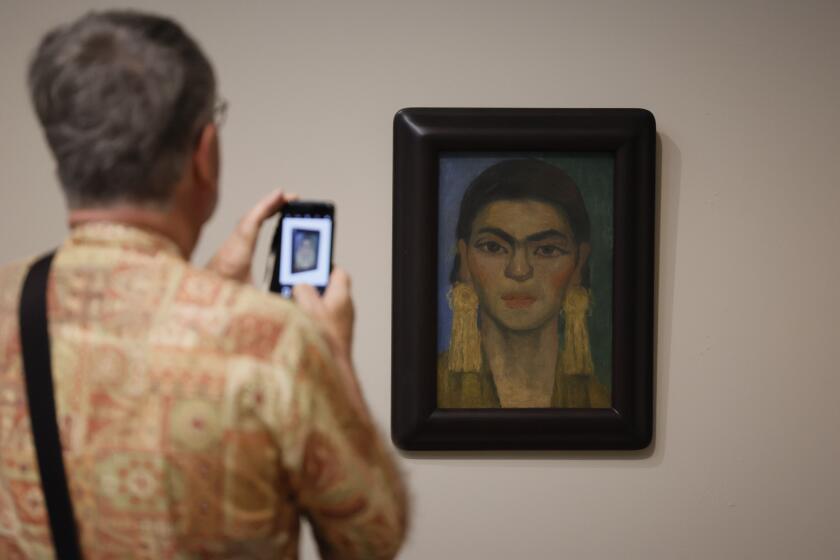Sellars Does Debussy : Something is lost in translation as the iconoclastic director turns his attention to ‘Pelleas et Melisande.’
So Peter Sellars has had his way with “Pelleas et Melisande.” The brilliant, dauntlessly inventive, intrinsically naughty boy has struck again.
Goodness gracious. O, mon Dieu .
When Sellars is stimulating--as in his historic Mozart “trilogy”--he’s very stimulating indeed. When he’s bad, he’s irksome.
Sellars’ “Pelleas et Melisande,” we fear, is irksome.
Never mind. Debussy will survive.
After the 3 1/2-hour marathon of muted modernist distortion drew to a merciful close Saturday night at the Dorothy Chandler Pavilion, the response out front was telling. The capacity crowd in the 3,200-seat hall--a hall patently too large for so delicate a challenge--had shrunk appreciably. Those who stayed for the curtain calls justly applauded a talented cast, hard-working and dedicated beyond the call. The crowd heaped understandable ovations on Esa-Pekka Salonen, a major-league conductor presiding for once in the Music Center Opera pit.
Finally Sellars, stoic and brave, took his bow. He was instantly serenaded by a lusty chorus of boos punctuated with defensive cheers. He grinned. He has heard this chorus before. If he ever failed to hear it, he might think he was a failure.
Failure, of course, is a relative thing. Sellars has succeeded in forcing us to think about “Pelleas et Melisande,” its psychological meaning for contemporary audiences and its possible sociopolitical subtexts. That’s nice.
At the same time, the director has introduced overlapping layers of obfuscation. He has made the timeless look merely trendy. He has permitted an unintentional element of earthy mirth to tarnish an elusive tragedy. Most distressing, perhaps, he has churned the poetry of Debussy’s score and Maeterlinck’s text into vulgar prose.
At his best, Sellars has always been true to the composer--his expressive dynamic, if you will--even when he has contradicted the librettist. At his worst, he has trampled both music and words in order to ram home a message of his own. Much of this effort, we fear, finds Sellars ramming and raving.
Remember “Pelleas et Melisande”?
First performed in Paris 92 years ago, the opera has always--well, almost always--thrived on its precious, mythical, even mystical distance. The locale is a kingdom called Allemonde. It usually looks vaguely medieval. The heroine, about whom all the inaction revolves, is a mysterious, fragile, otherworldly creature--half woman, half child, encumbered by her symbolist creator with sensuous blond hair long enough to reach from a tower to the eager hands of a lover on the floor below.
Melisande inhabits a misty, shadowy never-never world specifically embellished with a forest, castle, spring, fountain, cave, vault and bedchamber. We know nothing of her past. We do know, however, that her lack of passion inspires extreme passion--suppressed in the best ancient-Gallic fashion--in anyone who crosses her innocent path.
Forget all that.
Sellars reduces “Pelleas et Melisande” to a soap opera about the tribulations of a dysfunctional family in contemporary Malibu. Repeat: Malibu.
That shouldn’t be too surprising. His recent “Merchant of Venice” took place in Venice, California , and Shylock the Jew turned out to be an African American.
In Sellars’ essentially naturalistic “Pelleas,” the unhappy Golaud turns out to be black too. This bit of non-traditional casting would be irrelevant, were it not for details that complicate the plot: Pelleas, Golaud’s victim, rival and half-brother, is white. More important, Sellars’ African American Golaud spends a lot of time abusing, and ultimately killing, his wife. The connections with a certain all-American court case may be coincidental, but that makes the parallels no less troubling.
In Sellars’ universe, harsh reality replaces gentle dreams. George Tsypin’s unit set, imported from Amsterdam, is a bleak, sterile, multi-room house--or fortress or bunker or hospital or ship--by the sea. The front wall is conveniently cut away.
The forest, specifically described in the opening line, is a figment of Golaud’s tortured mind. The spring is a huge sewer pipe. The sea is a blue network of neon and fluorescent tubes flashing intermittently on the floor (and, no doubt, blinding patrons seated on the upper levels).
The mysterious Melisande has become the wholesome co-ed next door, who cuts her hair reasonably short and likes to model sweat suits and jeans (designer: Dunya Ramicova). The heroine is palpably pregnant in mid-opera. Golaud kicks her in the stomach.
And so it goes. Slowly. Very slowly.
One has to admire Sellars’ imagination, stubborn though it may be. One also has to deplore his excesses, including one simplistic subplot involving an army of L.A. cops menacing a trio of homeless persons and another presenting a Greekish chorus of angelic nurses who mime homely benedictions.
The pathetic Arkel clan is crumbling, and so is the surrounding civilization. Get it? It is very deep.
Ultimately, one has to worry about the trivialization of a masterpiece. It is hard enough to vitalize the wispy emotions of “Pelleas et Melisande” under the best of conventional conditions. Sellars makes that task even harder.
In this odd dramatic context, and with distracting supertitles (which Sellars used to oppose) flashing across the proscenium, the music is almost reduced to background accompaniment. This is doubly sad because the musicmaking, much of the time, is superb.
Conducting opera for this first time in the States (and replacing the originally scheduled Simon Rattle), Salonen enforces a sweeping scale of passion and a fine sense of theatrical point. He obviously favors the robust modern approach pioneered by Pierre Boulez rather than the more ethereal attitudes of old Pierre Monteux and Ernest Ansermet. Still, he supports the mutterings on the stage with restraint as needed, and propels the drama with a fine heroic sweep wherever possible--especially in the orchestral interludes now appropriated to illustrate mime divertissements. He also elicits dazzling playing from 66 members of the Los Angeles Philharmonic.
The splendid cast does what it can. As Pelleas, Francois LeRoux makes up in baritonal grace and verbal sensitivity for what he may lack in histrionic ardor. Monica Groop, the Finnish mezzo-soprano who replaced Elise Ross as Melisande, looks lovely, if a bit too wholesome, and sings with striking purity and suavity. Willard White broods and stalks the boards with dangerous repression as the deep-toned Golaud.
Kenneth Cox invests the laments of old Arkel with reasonable dignity and cavernous basso tone. Delia Wallis, though a bit light in timbre, exudes crisp sympathy as the maternal Genevieve. Gaele Le Roi introduces a nimble, surprisingly boyish Yniold.
John Atkins goes through his practiced Sharpless routines on behalf of the nice walk-on Doctor. Disguised as a policeman, Tod Fitzpatrick manages to usurp the Shepherd’s lines effectively, and Jules Mandel holds his own poignantly as Pelleas’ pathetic father--a silent role invented by Sellars.
*
“Pelleas et Melisande,” presented by the Music Center Opera at the Dorothy Chandler Pavilion , 135 N. Grand Ave. Remaining performances Tuesday, Friday and Sunday at 8 p.m. Tickets $21 to $115 (student and senior rush seats, $10, one hour before curtain if available). Information: (213) 972-7211.
More to Read
The biggest entertainment stories
Get our big stories about Hollywood, film, television, music, arts, culture and more right in your inbox as soon as they publish.
You may occasionally receive promotional content from the Los Angeles Times.






